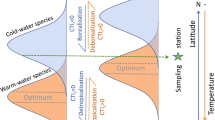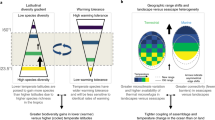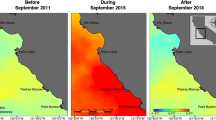Abstract
Extreme climatic events, such as heat waves, are predicted to increase in frequency and magnitude as a consequence of global warming but their ecological effects are poorly understood, particularly in marine ecosystems1,2,3. In early 2011, the marine ecosystems along the west coast of Australia—a global hotspot of biodiversity and endemism4,5—experienced the highest-magnitude warming event on record. Sea temperatures soared to unprecedented levels and warming anomalies of 2–4 °C persisted for more than ten weeks along >2,000 km of coastline. We show that biodiversity patterns of temperate seaweeds, sessile invertebrates and demersal fish were significantly different after the warming event, which led to a reduction in the abundance of habitat-forming seaweeds and a subsequent shift in community structure towards a depauperate state and a tropicalization of fish communities. We conclude that extreme climatic events are key drivers of biodiversity patterns and that the frequency and intensity of such episodes have major implications for predictive models of species distribution and ecosystem structure, which are largely based on gradual warming trends.
This is a preview of subscription content, access via your institution
Access options
Subscribe to this journal
Receive 12 print issues and online access
$209.00 per year
only $17.42 per issue
Buy this article
- Purchase on Springer Link
- Instant access to full article PDF
Prices may be subject to local taxes which are calculated during checkout




Similar content being viewed by others
References
Munday, P. L., Jones, G. P., Pratchett, M. S. & Williams, A. J. Climate change and the future for coral reef fishes. Fish Fisheries 9, 261–285 (2008).
Hegerl, G. C., Hanlon, H. & Beierkuhnlein, C. Climate science: Elusive extremes. Nature Geosci. 4, 142–143 (2011).
Jentsch, A., Kreyling, J. & Beierkuhnlein, C. A new generation of climate-change experiments: Events, not trends. Front. Ecol. Environ. 5, 365–374 (2007).
Tittensor, D. P. et al. Global patterns and predictors of marine biodiversity across taxa. Nature 466, 1098–1101 (2010).
Kerswell, A. P. Biodiversity patterns of benthic marine algae. Ecology 87, 2479–2488 (2006).
Rosenzweig, C. et al. Attributing physical and biological impacts to anthropogenic climate change. Nature 453, 353–357 (2008).
Cheung, W. W. L. et al. Climate-change induced tropicalisation of marine communities in Western Australia. Mar. Freshwat. Res. 63, 415–427 (2012).
Hawkins, S. et al. Consequences of climate-driven biodiversity changes for ecosystem functioning of North European rocky shores. Mar. Ecol. Prog. Ser. 396, 245–259 (2009).
Kerr, R. A. Humans are driving extreme weather; time to prepare. Science 334, 1040 (2011).
Lough, J. M. 1997-98: Unprecedented thermal stress to coral reefs? Geophys. Res. Lett. 27, 3901–3904 (2000).
Dayton, P. K. & Tegner, M. J. Catastrophic storms, El Niño, and patch stability in a southern California kelp community. Science 224, 283–285 (1984).
Garrabou, J. et al. Mass mortality in Northwestern Mediterranean rocky benthic communities: Effects of the 2003 heat wave. Glob. Change Biol. 15, 1090–1103 (2009).
Lima, F. P. & Wethey, D. S. Three decades of high-resolution coastal sea surface temperatures reveal more than warming. Nature Commun. 3, 704 (2012).
Selig, E. R., Casey, K. S. & Bruno, J. F. New insights into global patterns of ocean temperature anomalies: Implications for coral reef health and management. Glob. Ecol. Biogeogr. 19, 397–411 (2010).
Pearce, A. et al. The Marine Heat Waveoff Western Australia during the Summer of 2010/11. Fisheries Research Report No. 222 (Department of Fisheries, 2011).
Levitus, S., Antonov, J. & Boyer, T. Warming of the world ocean 1955–2003. Geophys. Res. Lett. 32, L02604 (2005).
Smale, D. A., Kendrick, G. A. & Wernberg, T. Assemblage turnover and taxonomic sufficiency of subtidal macroalgae at multiple spatial scales. J. Exp. Mar. Biol. Ecol. 384, 76–86 (2010).
Langlois, T. J. et al. Consistent abundance distributions of marine fishes in an old, climatically buffered, infertile seascape. Glob. Ecol. Biogeogr.http://dx.doi.org/10.1111/j.1466-8238.2011.00734.x (2011).
Wernberg, T., Thomsen, M. S., Tuya, F. & Kendrick, G. A. Biogenic habitat structure of seaweeds change along a latitudinal gradient in ocean temperature. J. Exp. Mar. Biol. Ecol. 400, 264–271 (2011).
Staehr, P. A. & Wernberg, T. Physiological responses of Ecklonia radiata (Laminariales) to a latitudinal gradient in ocean temperature. J. Phycol. 45, 91–99 (2009).
Dayton, P. K. Ecology of kelp communities. Ann. Rev. Ecol. Syst. 16, 215–245 (1985).
Steneck, R. S. et al. Kelp forest ecosystems: Biodiversity, stability, resilience and future. Environ. Conserv. 29, 436–459 (2002).
Gorman, D. & Connell, S. D. Recovering subtidal forests in human-dominated landscapes. J. Appl. Ecol. 46, 1258–1265 (2009).
Wernberg, T. & Connell, S. D. Physical disturbance and subtidal habitat structure on open rocky coasts: Effects of wave exposure, extent and intensity. J. Sea Res. 59, 237–248 (2008).
Caputi, N., Fletcher, W. J., Pearce, A. & Chubb, C. F. Effect of the Leeuwin Current on the recruitment of fish and invertebrates along the Western Australian coast. Mar. Freshwat. Res. 47, 147–155 (1996).
Figueira, W. F. & Booth, D. J. Increasing ocean temperatures allow tropical fishes to survive overwinter in temperate waters. Glob. Change Biol. 16, 506–516 (2010).
Dayton, P. K., Tegner, M. J., Parnell, P. E. & Edwards, P. B. Temporal and spatial patterns of disturbance and recovery in a kelp forest community. Ecol. Monogr. 62, 421–445 (1992).
Wernberg, T. et al. Decreasing resilience of kelp beds along a latitudinal temperature gradient: Potential implications for a warmer future. Ecol. Lett. 13, 685–694 (2010).
Tuya, F., Wernberg, T. & Thomsen, M. S. Testing the ‘abundant centre’ hypothesis on endemic reef fishes in south-western Australia. Mar. Ecol. Prog. Ser. 372, 225–230 (2008).
Anderson, M. J., Gorley, R. N. & Clarke, K. R. PERMANOVA+ for PRIMER: Guide to Software and Statistical Methods 2nd edn 214 (PRIMER-E Ltd, 2008).
Day, R. W. & Quinn, G. P. Comparisons of treatments after an analysis of variance in ecology. Ecol. Monogr. 59, 433–463 (1989).
Acknowledgements
This research was supported by Australian Research Council grants to T.W. Blended sea surface temperature anomalies were provided by the National Weather Service and the NOAA Operational Model Archive Distribution System. J. Zinke commented on the manuscript and provided assistance with the HadISST1 data.
Author information
Authors and Affiliations
Contributions
T.W. conceived the research programme and secured financial support. D.A.S. and T.W. contributed equally to the conceptualization and development of the paper. D.A.S. wrote most of the paper, with assistance from T.W., and carried out most analyses, with assistance from T.W. and T.J.L. Fieldwork was orchestrated by T.W. and conducted by T.W., F.T., T.d.B., M.S.T., S.B., T.J.L. and D.A.S. Analysis of temperature data was carried out by C.S.R. and T.W., with assistance from D.A.S. All authors discussed the results.
Corresponding authors
Ethics declarations
Competing interests
The authors declare no competing financial interests.
Supplementary information
Supplementary Information
Supplementary Information (PDF 1048 kb)
Rights and permissions
About this article
Cite this article
Wernberg, T., Smale, D., Tuya, F. et al. An extreme climatic event alters marine ecosystem structure in a global biodiversity hotspot. Nature Clim Change 3, 78–82 (2013). https://doi.org/10.1038/nclimate1627
Received:
Accepted:
Published:
Issue Date:
DOI: https://doi.org/10.1038/nclimate1627
This article is cited by
-
Weather-dependent changes in habitat use by Alpine chamois
Movement Ecology (2024)
-
Deep learning-based forecasting of sea surface temperature in the interim future: application over the Aegean, Ionian, and Cretan Seas (NE Mediterranean Sea)
Ocean Dynamics (2024)
-
Meta-analysis reveals less sensitivity of non-native animals than natives to extreme weather worldwide
Nature Ecology & Evolution (2023)
-
Rapid tropicalization evidence of subtidal seaweed assemblages along a coastal transitional zone
Scientific Reports (2023)
-
Marine protected areas, marine heatwaves, and the resilience of nearshore fish communities
Scientific Reports (2023)



